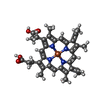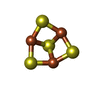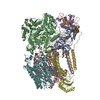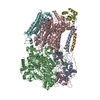+Search query
-Structure paper
| Title | Cryo-EM structure of HQNO-bound Alternative Complex III from the anoxygenic phototrophic bacterium Chloroflexus aurantiacus. |
|---|---|
| Journal, issue, pages | Plant Cell, Year 2024 |
| Publish date | Jan 31, 2024 |
 Authors Authors | Jiyu Xin / Zhenzhen Min / Lu Yu / Xinyi Yuan / Aokun Liu / Wenping Wu / Xin Zhang / Huimin He / Jingyi Wu / Yueyong Xin / Robert E Blankenship / Changlin Tian / Xiaoling Xu /   |
| PubMed Abstract | Alternative complex III (ACIII) couples quinol oxidation and electron acceptor reduction with potential transmembrane proton translocation. It is compositionally and structurally different from the ...Alternative complex III (ACIII) couples quinol oxidation and electron acceptor reduction with potential transmembrane proton translocation. It is compositionally and structurally different from the cytochrome bc1/b6f complexes, but functionally replaces these enzymes in the photosynthetic and/or respiratory electron transport chains (ETCs) of many bacteria. However, the true compositions and architectures of ACIIIs remain unclear, as do their structural and functional relevance in mediating the ETCs. We here determined cryogenic electron microscopy structures of photosynthetic ACIII isolated from Chloroflexus aurantiacus (CaACIIIp), in apo-form and in complexed form bound to a menadiol analog 2-heptyl-4-hydroxyquinoline-N-oxide (HQNO). Besides six canonical subunits (ActABCDEF), the structures revealed conformations of two previously unresolved subunits, ActG and I, which contributed to the complex stability. We also elucidated the structural basis of menaquinol oxidation and subsequent electron transfer along the [3Fe-4S]-6 hemes wire to its periplasmic electron acceptors, using electron paramagnetic resonance (EPR), spectroelectrochemistry, enzymatic analyses and molecular dynamics (MD) simulations. A unique insertion loop in ActE was shown to function in determining the binding specificity of CaACIIIp for downstream electron acceptors. This study broadens our understanding of the structural diversity and molecular evolution of ACIIIs, enabling further investigation of the (mena)quinol oxidoreductases evolved coupling mechanism in bacterial energy conservation. |
 External links External links |  Plant Cell / Plant Cell /  PubMed:38299372 PubMed:38299372 |
| Methods | EM (single particle) |
| Resolution | 2.7 - 3.33 Å |
| Structure data | EMDB-36984, PDB-8k9e: EMDB-36985, PDB-8k9f: EMDB-38012, PDB-8x2j: |
| Chemicals |  ChemComp-HEC:  ChemComp-SF4:  ChemComp-F3S:  ChemComp-EL6: 
ChemComp-JLQ: 
ChemComp-JL3: 
ChemComp-JM9:  ChemComp-MG:  ChemComp-HQO: |
| Source |
|
 Keywords Keywords |  MEMBRANE PROTEIN / Photosynthetic alternative complex III MEMBRANE PROTEIN / Photosynthetic alternative complex III |
 Movie
Movie Controller
Controller Structure viewers
Structure viewers About Yorodumi Papers
About Yorodumi Papers











